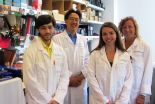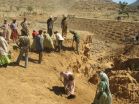(Press-News.org) Sydney, Australia -- Creating futuristic, next generation materials called 'metallic glass' that are ultra-strong and ultra-flexible will become easier and cheaper, based on UNSW Australia research that can predict for the first time which combinations of metals will best form these useful materials.
Just like something from science fiction - think of the Liquid-Metal Man robot assassin (T-1000) in the Terminator films - these materials behave more like glass or plastic than metal.
While still being metals, they become as malleable as chewing gum when heated and can be easily moulded or blown like glass. They are also three times stronger and harder than ordinary metals, on average, and are among the toughest materials known.
"They have been described as the most significant development in materials science since the discovery of plastics more than 50 years ago," says study author, Dr Kevin Laws, from UNSW Australia in Sydney.
Most metals are crystalline when solid, with their atoms arranged in a highly organised and regular manner. Metallic glass alloys, however, have a highly disordered structure, with the atoms arranged in a non-regular way.
"There are many types of metallic glass, with the most popular ones based on zirconium, palladium, magnesium, titanium or copper. But until now, discovering alloy compositions that form these materials has required a lengthy process of trial and error in the laboratory," says Dr Laws.
In the new study, published in the journal Nature Communications, Dr Laws and his colleagues describe a unique new model of the atomic structure of metallic glass, which allows scientists to predict the metal combinations that will have glass-forming ability.
They have used their model to successfully predict more than 200 new metallic glass alloys based on magnesium, silver, copper, zinc and titanium in the past few years.
"With our new instruction manual we can start to create many new useful metallic glass-types and begin to understand the atomic fundamentals behind their exceptional properties. We will also be able to engineer these materials on an atomic scale so they have the specific properties we want," says Dr Laws.
"Metallic glass alloys are expensive to manufacture and to date have only been used in niche products, such as ejector pins for iPhones, watch springs for expensive hand-wound watches, trial medical implants, and tennis racquets and golf clubs. They are also planned for use in the next Mars rover vehicle.
"But if they become easier and cheaper to make, they could be widely used in many applications including as exceptionally strong components in personal electronic devices, in space exploration vehicles, and as hydrogen storage materials in next generation batteries."
INFORMATION:
The research team includes Dr Laws and Professor Michael Ferry of the UNSW School of Materials Science and Engineering, and Dr Daniel Miracle of the Air Force Research Laboratory, US Materials and Manufacturing Directorate.
BERKELEY -- A new study by University of California, Berkeley, researchers establishes for the first time a link between infection with the bovine leukemia virus and human breast cancer.
In the study, published this month in the journal PLOS ONE and available online, researchers analyzed breast tissue from 239 women, comparing samples from women who had breast cancer with women who had no history of the disease for the presence of bovine leukemia virus (BLV). They found that 59 percent of breast cancer samples had evidence of exposure to BLV, as determined by the presence ...
Planning conservation actions requires up-to-date information on
Biodiversity is diminishing at unprecedented rates, and quick decisions are needed in what and where to protect.
"The decisions should be based on comprehensive information, but scientists do not have enough resources to collect more data and effectively monitor all species and habitats that need protection. As human are the main driving force of global change, conservation also needs information on human presence and behaviour" says Enrico Di Minin, a researcher in conservation science at the Department ...
A new study has found increasing support in the United States and Canada for smokefree laws for outdoor areas, especially in playgrounds and school grounds.
The collaborative study between the University of Otago, New Zealand and University of Alberta, Canada, provides new and some unexpected insights for health promotion in North America. A key finding is that most residents welcome smokefree laws. Support was strongest for smokefree playgrounds and school grounds, but there was also majority support for a range of other smokefree areas.
University of Otago, Wellington ...
Highly diluted acetic acid, an active ingredient of household vinegar, has been shown to be an effective alternative agent to prevent infection and kill bacteria found in burn wounds.
Researchers from the University of Birmingham and the National Institute for Health Research (NIHR) Surgical Reconstruction and Microbiology Research Centre (SRMRC) investigated the antibacterial activity of acetic acid against key burn wound colonising organisms growing both planktonically and as biofilms.
Burns are a common traumatic injury and prone to becoming infected due to loss ...
On Sept. 13, 2015, as NASA's Solar Dynamics Observatory, or SDO, kept up its constant watch on the sun, its view was photobombed not once, but twice. Just as the moon came into SDO's field of view on a path to cross the sun, Earth entered the picture, blocking SDO's view completely. When SDO's view of the sun emerged from Earth's shadow, the moon was just completing its journey across the sun's face.
Though SDO sees dozens of Earth eclipses and several lunar transits each year, this is the first time ever that the two have coincided. This alignment of the sun, moon and ...
New research from the University of Washington's Friday Harbor Laboratories shows that a more acidic ocean can weaken the protective shell of a delicate alga. The findings, published Sept. 9 in the journal Biology Letters, come at a time when global climate change may increase ocean acidification.
The creature in question is Acetabularia acetabulum, commonly called the mermaid's wineglass. Reaching a height of just a few inches, this single-celled alga lives on shallow seafloors, where sunlight can still filter down for photosynthesis. Like many marine creatures, the ...
UC San Francisco has received a National Cancer Institute grant of $5 million over the next five years to lead a massive effort to integrate the data from all experimental models across all types of cancer. The web-based repository is an important step in moving the fight against cancer toward precision medicine.
The goal is to accelerate cancer research to improve the way we diagnose, treat and conduct further research on the disease. The resulting database, called the Oncology Models Forum (OMF), will be accessible to researchers through the National Institutes of ...
Current drugs may stop working against the most common type of brain tumor in children, medulloblastoma, but the tumor could be targeted in a new way, according to Stanford University scientists.
In research to be published in the journal eLife, a team led by Prof. Matthew P. Scott at the University's School of Medicine tested a drug called Roflumilast in mice with a brain tumor that is resistant to Vismodegib, the drug in current use. Roflumilast is normally used to treat inflammatory lung diseases. It dramatically inhibited tumor growth from the first day of treatment. ...
This news release is available in French.
Montreal, September 15th 2015 - It is estimated that half of all cancer patients suffer from a muscle wasting syndrome called cachexia. Cancer cachexia impairs quality of life and response to therapy, which increases morbidity and mortality of cancer patients. Currently, there is no approved treatment for muscle wasting but a new study from the Research Institute of the McGill University Health Centre (RI-MUHC) and University of Alberta could be a game changer for patients, improving both quality of life and longevity. The ...
To better inform the tradeoffs involved in land use choices around the world, experts have assessed the value of ecosystem services provided by land resources such as food, poverty reduction, clean water, climate and disease regulation and nutrients cycling.
Their report today estimates the value of ecosystem services worldwide forfeited due to land degradation at a staggering US $6.3 trillion to $10.6 trillion annually, or the equivalent of 10-17% of global GDP.
Furthermore, the problem threatens to force the migration of millions of people from affected areas. ...



